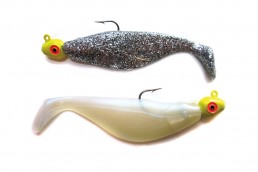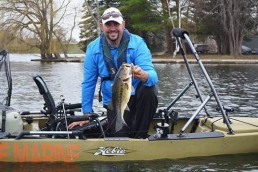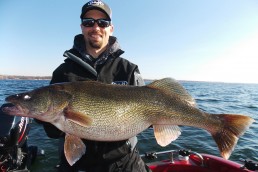The Swim Jig and Soft Swimbait Ensemble
SHARE THIS POST
Swim jigs defy rigid category; some insist they aren’t really jigs. The truth is standard, swimming skirted jigs have been deployed by largemouth anglers for some time now. Swim jigs are rigged with a variety of soft plastic trailers, ranging from crawfish to creatures to minnow profiles. These may not have been the first choices or presentation most have thought about when using a jig, but it certainly adds a higher level of fish-catching ability with the simple turns of a reel.
A bulk of jig fishing is thought of in terms of imparting the wrist for an up and down jigging motion. After all, that is what jigging is. But if you already have an effective jig, plastic or pork combo, what would be the harm in swimming that over the tips of cover with a steady cranking motion imitating a baitfish, or just letting the jig hit the bottom followed by a slow, steady retrieve that mimics a crawfish?
Now you’re talking about one lure for the shallows, flats and depths.
Swim jig origins
The Cottee Liv’ Eye Action Jig was one of the original swim jigs that spiraled. It consists of a cone- shaped, barbed lead-head jig, and offers a “corkscrew” falling motion. This was usually rigged with a shad (soft swimbait) body. Those pursuing bonefish have used these prior to anglers that were situated away from the coastal waters.
I was a bit skeptical when my uncle, who resided in Florida, sent me a Cottee Liv’ Eye rigged with a gold-flecked, shad-style bait in the mid-’90s. My father wasted no time in proclaiming it was, “The ugliest” lure ever seen.”
The first warm day in March led us out to a small, early-warming lake. My fifth cast hit a 12-foot drop-off. A 20-inch largemouth that inhaled the Cottee/shad pattern convinced us both the tandem needed some serious evaluation.
Are you enjoying this post?
You can be among the first to get the latest info on where to go, what to use and how to use it!
We were both surprised at the shake, rattle and roll the rigging allowed on the drop. This was before swim jigs became more mainstream, and we were under the impression this exotic Florida jig was a rare and wondrous thing. That big bass certainly turned out to be a life lesson in terms of jig perception.
Soft swimbait rigging options
Using our senses offers only an inkling of how a bass is going to react. Therefore, it’s important to allow jigs to shine. Specific jig/plastic/pork combos work well on certain bodies of water, but to be a jig master you really have to make the commitment to push jig fishing to the limits in terms of experimentation using a variety of heads and bodies. The good news is there are so many on the market it does not take long to find what works.
Newer swim jigs are skirted. If you have fished a spinnerbait before, that’s how you reel in swim jigs, with the same, steady retrieve. They are a touch more weedless than spinnerbaits due to the lack of a spinnerbait arm, clevice and blade(s), making the swim jigs more suited for heavier cover. Spinnerbaits just don’t work as well in summer peak conditions due to weed growth. Sleeker, more weedless options, like the swim jigs, catch more fish because they’re in the strike zone longer, avoiding hang-ups.
Another great asset of the swim jig is if you prefer baitcasting tackle to spinning tackle. The combination of a jig head and larger plastic trailer means more often than not you will be casting a package weighing around 1/2 ounce in the Midwest. Jig skirts can be trimmed or changed, offering the ability to tailor them to your liking.
Unlike crankbaits, jerkbaits or topwaters, swim jigs can be adjusted quickly, offering a desirable level of versatility for largemouth anglers seeking fish in and around cover. It’s also great for those using a minimal amount of rods. Swimbaits that have longer bodies and tails or grooves will offer a fair amount of resistance when retrieved. If you’re after a big bass, this choice is advantageous due to the larger-profile body on the slower-falling offering. Combine that with the weedless characteristics of swim jigs, and you have an effective searching tool on a baitcasting outfit for distance, speed control and sink rate. The ability to work around all desired cover and structure is only amplified as a jig and trailer’s plump profile transmits a higher rate of vibration through the lateral line of the bass.
In terms of the bass lure family, there probably isn’t any other lure-rigging option that is going to offer you all of those advantages when casting gear is implemented. The humble origins of the swim jig have led to a vast family of designs, but the key is to put the right piece in the proper place to complete the puzzle we largemouth anglers enjoy working annually.
MWO
SHARE THIS POST
Did you enjoy this post?
You can be among the first to get the latest info on where to go, what to use and how to use it!
Frank Racz
With almost two decades of fishing retail knowledge, Frank Racz’s dedication to the “stitching technique” has led to a modern Midwestern largemouth bass variant and bluegill pursuits. He is avid about the techniques’ multispecies potential and other long spinning rod inquiries featured on his YouTube channel.



